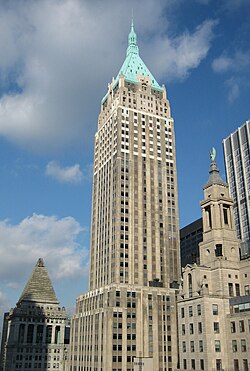
| ||
|---|---|---|
Related |
||
The Marcos family, a political family in the Philippines, owns various assets that Philippine courts have determined to have been acquired through illicit means during the presidency of Ferdinand Marcos from 1965–1986.[1][2] These assets are referred to using several terms, including "ill-gotten wealth"[3] and "unexplained wealth,"[4] while some authors such as Belinda Aquino and Philippine Senator Jovito Salonga more bluntly refer to it as the "Marcos Plunder".[4][5]
Legally, the Philippine Supreme Court defines this "ill-gotten wealth" as the assets the Marcoses acquired beyond the amount legally declared by Ferdinand and Imelda Marcos in the president's statements of assets and liabilities[3]—which amounts to only about US$13,500.00 from his salary as president. The court also deems that such wealth should be forfeited and turned over to the government or of the human rights victims of Marcos's authoritarian regime.[6] Estimates of the amount the Marcoses reportedly acquired in the last few years of the Marcos administration range from US$5 billion to $13 billion.[7]: 634–635 [8]: 27 No exact figures can be determined for the amount acquired through the entire 21 years of the Marcos regime, but prominent Marcos-era economist Jesus Estanislao has suggested that the amount could be as high as US$30 billion.[9]: 175
Among the sources of the Marcos wealth are alleged to be: diverted foreign economic aid, US Government military aid (including huge discretionary funds at Marcos disposal as a "reward" for sending some Filipino troops to Vietnam) and kickbacks from public works contracts over a two-decades-long rule.[10]
This wealth includes: real estate assets both within the Philippines and in several other countries, notably the United States; collections of jewelry and artwork; shares and other financial instruments; bank accounts, both in the Philippines and overseas, notably Switzerland, the United States, Singapore, and the British Virgin Islands;[11][12] and in some instances, actual cash assets.[13]
Some of this wealth has been recovered as the result of various court cases, either as funds or properties returned to the Philippine government, or by being awarded as reparations to the victims of human rights abuses under Marcos's presidency.[14][15] Some of it has also been recovered by the Philippine government through settlements and compromise deals, either with the Marcoses themselves or with cronies who said that certain properties had been entrusted to them by the Marcoses.[13] Some of the recovery cases have been dismissed by the courts for reasons including improper case filing procedures and technical issues with documentary evidence.[16] An unknown amount[8] is not recoverable because the full extent of the Marcos wealth is unknown.[1]
- ^ a b Davies, Nick (May 7, 2016). "The $10bn question: what happened to the Marcos millions?". The Guardian.
- ^ Tiongson-Mayrina, Karen and GMA News Research.September 21, 2017. The Supreme Court's rulings on the Marcoses' ill-gotten wealth. https://www.gmanetwork.com/news/news/specialreports/626576/the-supreme-court-s-rulings-on-the-marcoses-ill-gotten-wealth/story/
- ^ a b IMELDA ROMUALDEZ-MARCOS, vs. REPUBLIC OF THE PHILIPPINES, G.R. No. 189505 (Supreme Court of the Philippines April 25, 2012), archived from the original on March 10, 2019.
- ^ a b R., Salonga, Jovito (2000). Presidential plunder: the quest for the Marcos ill-gotten wealth. [Quezon City]: U.P Center for Leadership, Citizenship and Democracy. ISBN 971-8567-28-3. OCLC 44927743.
{{cite book}}: CS1 maint: multiple names: authors list (link) - ^ Aquino, Belinda A. (1999). The transnational dynamics of the Marcos Plunder. University of the Philippines, National College of Public Administration and Governance. ISBN 978-971-8567-19-7. OCLC 760665486.
- ^ "Marcoses lose US appeal". Philippine Daily Inquirer.
- ^ Subcommittee on Asian and Pacific Affairs, United States Congress House Committee on Foreign Affairs (1987). Investigation of Philippine Investments in the United States: Hearings Before the Subcommittee on Asian and Pacific Affairs of the Committee on Foreign Affairs, House of Representatives, Ninety-ninth Congress, First and Second Sessions, December 3, 11, 12, 13, 17, and 19, 1985; January 21, 23, and 29; March 18 and 19; April 9 and 17, 1986. U.S. Government Printing Office.
- ^ a b Romero, Jose V. Jr. (2008). Philippine political economy. Quezon City, Philippines: Central Book Supply. ISBN 978-971-691-889-2. OCLC 302100329.
- ^ Fischer, Heinz-Dietrich, ed. (January 20, 2020). 1978–1989: From Roarings in the Middle East to the Destroying of the Democratic Movement in China (Reprint 2019 ed.). Berlin: Walter de Gruyter GmbH & Co KG, 2020. ISBN 978-3-11-086292-8. OCLC 1138498892.
- ^ Lirio, Gerry. "Time taking its toll on martial law victims". ABS-CBN News.
- ^ Manapat, Ricardo (1991). Some are smarter than others: the history of Marcos' crony capitalism. Aletheia Publications. ISBN 978-971-91287-0-0. OCLC 28428684.
- ^ Research, Inquirer (September 17, 2017). "Where Marcos stashed multibillion loot". The Philippine Daily Inquirer. Archived from the original on September 17, 2017. Retrieved June 23, 2020.
- ^ a b Through the Years, PCGG at 30: Recovering Integrity –A Milestone Report. Manila: Republic of the Philippines Presidential Commission on Good Government. 2016.
- ^ Cite error: The named reference
RapplerCaseStatuswas invoked but never defined (see the help page). - ^ Rappler. Rappler Talk: Ang mga gusaling nabili ng mga Marcos sa ill-gotten wealth (in Filipino).
- ^ "VERA FILES FACT CHECK: Bongbong Marcos falsely claims martial law horrors fabricated". Vera Files.


